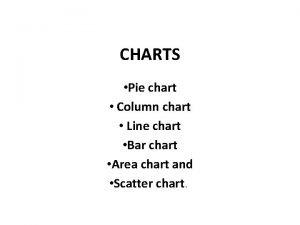Wall chart for Latin American Countries Mauricio Holz





















- Slides: 21

Wall chart for Latin American Countries Mauricio Holz UN-CELADE/ECLAC

Will be the best Wall chart in the history of Wall charts! (The first Wall chart in human history) Altamira cave, prehistoric Anonymous man

Structure § Two kinds of information – Demographic and Economic measures for 30 Latin American and Caribbean Countries – Comparison between NTA Latin American Countries and other NTA regions using National Transfers Accounts.

Demographic and economic measures for 30 Latin American and Caribbean Countries § Life Expectancy, TFR, percentage of population 65+ and below 15, in 2010 and 2040 § Year in which old consumption is higher relative to young consumption. § Intergenerational (Tax) Reallocation Rate for young dependency group and for old dependency group. § Five statistics of the first Demographic Dividend. § Economic dependency measures by social sectors.

Percentage of population 65+. 2010 and 2040

Year in which old consumption is higher compare to young consumption. § Using support ratios we calculated the year in which 65+ relative effective consumers are higher than <15 relative effective consumers for 30 LAC 2006 2049

Intergenerational (Tax) Reallocation Rate § Is the sum of the LCD of the dependency age group of young people as fraction of GDP, plus the LCD of the dependency age group of old people as a fraction of GDP

ITR and Ageing Cross sectional data

ITR and Ageing Cross sectional data § Cross sectional data seems to replicate the demographic dividend pattern of one country. – A sign of Heterogeneity in the ageing process between LAC. (Different stages in the process) – How much of this cross sectional data can be explained by demographic factors and by the LCD per-capita ages profiles? - How this graph will change when we include the NTA data for other Latin American countries. Maybe not much? - Is there some causality between the ageing process and the per-capita age profiles of LCD?

Statistics of the first demographic dividend § Min: The lowest value of the support ratio during the demographic dividend. § Year of Min: The year when the SR reach is lowest value. Represent the starting point of the first demographic dividend. § Max: The highest value of the support ratio during the demographic dividend. § Year of Max: The year when the SR reach is highest value. Represent the ending point of the first demographic dividend. § Duration of the demographic bond: The number of years between the lowest value and the highest value.

Economic dependency measure by social sectors, Health (Miller, Mason and Holz). Country Aggregate Spending (% GDP) Benefit Generosity Ratio (% of GDP per working-age adult) Dependency Ratio (% of working-age population) Cuba 7. 4 66 11 Colombia 6. 2 62 10 Costa Rica 5. 9 83 7 Argentina 4. 5 32 14 Nicaragua 3. 4 33 10 Uruguay 3. 4 20 17 Brazil 3. 1 28 11 Mexico 3. 0 35 9 Chile 2. 8 31 9 Peru 1. 5 15 10 Median, Latin America 3. 4 34 10 Mean, Latin America 4. 1 38 11 Mean, OECD 6. 9 46 15

Comparison between NTA Latin American Countries and other NTA regions using NTA data. § Support Ratio § Old consumption (65+) relative to young (<15) consumption § Old consumption (LCD age group) relative to young consumption (LCD age group) § Young age group of dependency § Old age group of dependency

Comparison between NTA Latin American Countries and other NTA regions using NTA data. § Distribution of public transfers in young age dependent group between: – Education – Health – Pensions – Other in Kind

Comparison between NTA Latin American Countries and other NTA regions using NTA data. § Distribution of public transfers in old age dependent group between: – Education – Health – Pensions – Other in Kind

Comparison between NTA Latin American Countries and other NTA regions using NTA data. § Intergenerational Reallocation Rate for young dependents, disaggregated in:

Comparison between NTA Latin American Countries and other NTA regions using NTA data. § Intergenerational Reallocation Rate for old dependents, disaggregated in:

Average Life Cycle Deficit for Latin American Countries

Average Finance of Consumption for LAC

Average Intergenerational Reallocation Rate

WORK IN PROGRESS!!!!

 Mauricio holz
Mauricio holz What are the experiences of latin american countries
What are the experiences of latin american countries Historischer hintergrund realismus
Historischer hintergrund realismus Bauwagen einrichten ideen
Bauwagen einrichten ideen Franziska holz
Franziska holz Arno holz rote dächer
Arno holz rote dächer Belmadur
Belmadur Katharina reiss functional theory
Katharina reiss functional theory Sound wall vs word wall
Sound wall vs word wall Wall to wall chris brown
Wall to wall chris brown Flemish bond t junction
Flemish bond t junction Members used to carry wall loads over wall openings
Members used to carry wall loads over wall openings The pod fruit develops from
The pod fruit develops from Mauricio gomez machado
Mauricio gomez machado Tourbillon de passions mauricio gonzáles
Tourbillon de passions mauricio gonzáles Padre mauricio loaiza
Padre mauricio loaiza San mauricio el greco
San mauricio el greco Mauricio lema medina
Mauricio lema medina Dr mauricio estrada
Dr mauricio estrada Dr mauricio estrada
Dr mauricio estrada Doctor mauricio maureira
Doctor mauricio maureira Mauricio borda
Mauricio borda









































